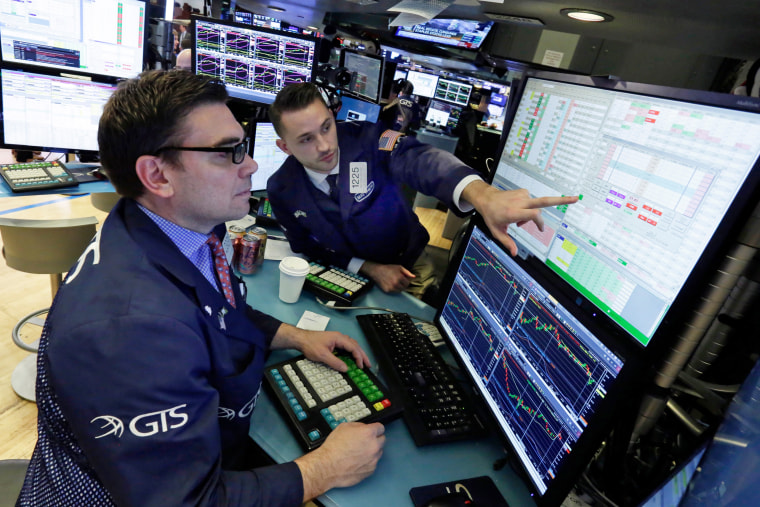Even an improving labor market can’t shake Wall Street's worry over the Trump administration’s tariff bluster. All three major indices saw sharp declines Friday, with the Dow Jones slumping by 767 points and entering correction territory — again — before closing down 576 points.
By the end of the day, the Dow and the S&P had suffered their worst day in two weeks; the Nasdaq and S&P were both down around 2.2 percent. All 30 companies that make up the Dow Jones index saw declines on Friday, with Caterpillar leading the losses — down 3.5 percent as the industrial sector bore the brunt of the trade war rhetoric.
Markets had seemingly brushed off the morning's disappointing jobs numbers, but a lunchtime comment by Treasury Secretary Steven Mnuchin set a sell-off in motion after he told CNBC, "There is the potential of a trade war."
“As long as uncertainty about trade persists, so too will the stomach-churning market volatility," said Greg McBride, chief financial analyst at Bankrate.com.
The White House pushed back on any implication that President Donald Trump's trade policies were negatively affecting the markets, with press secretary Sarah Huckabee Sanders telling reporters in a Friday briefing, "We're focused on the long-term economic principles."
Friday's jobs report data listed March gains at just 103,000 for the month — a disappointing figure even though unemployment remained at 4.1 percent and wage gains increased.
“It was surprisingly low,” said Andy Challenger, vice president at Challenger, Gray & Christmas. “It could be a sign of some tentativeness from employers.”
An upward revision of February’s already-blockbuster 313,000 job growth figure to 326,000 wasn’t enough to cancel out a downward revision of January’s labor market report, with a net 50,000 fewer jobs added in 2018 than previously believed. Still, economists pointed out that the three-month average — considered a more reliable metric than any single month’s figure — came in at a robust 202,000 jobs per month.
“I think the tariff situation, the trade war of words is probably weighing much more heavily on the market than the jobs report. The jobs report was a disappointment but not a disaster,” said Dan North, chief economist at Euler Hermes North America. “I really think it’s second in importance compared to what’s going on with the proposed tariffs,” he said.
“Rising interest rates and the threat of trade wars are a recipe for very volatile markets,” said Mark Zandi, chief economist at Moody’s Analytics. “Valuations are high, and are vulnerable,” he said.
“The bad news is with all the other craziness going on with the tariff situation and how that may or may not materialize into more jobs domestically,” said Robert Eyler, a board member of Redwood Credit Union and economist at Sonoma State University. “Short of the tariffs situation, our economy looks pretty good.”
Other economists also warned that the longer Trump’s protectionist rhetoric and threats of tariffs rattle investors, the more likely it is that the resultant volatility will start to spill over into the Main Street economy, hurting consumer confidence and workers’ job prospects.
"Corporate America’s worry over a trade war-induced market selloff could slow the momentum of job growth, just as last year’s soaring stocks helped buoy employment."
Guy Berger, chief economist at LinkedIn, said corporate America’s worry over a trade war-induced market selloff could slow the momentum of job growth, just as last year’s soaring stocks helped buoy employment.
“When equity prices go up, firms feel more confident,” he said. “It was a tailwind… there’s no doubt that it made a difference.”
Economists were divided on the significance of the 2.7 percent annualized gain in wage growth. It cheered market observers who have been concerned that stagnant pay has kept a wide swath of wage-earning Americans from sharing in the fruits of the economic recovery, but wasn’t so high as to spark inflationary fears — a worry that kicked off the current spate of market volatility two months earlier when January’s unexpectedly high wage growth caught investors by surprise.
“If this number had been 3 percent or higher, the market probably would’ve gotten hit pretty hard,” said Scott Wren, senior global equity strategist for Wells Fargo Investment Institute.
Traders view wage growth as a proxy for more broad-based inflation, he said, so a slow, incremental increase in wages would be likely to validate the Federal Reserve’s current rate-raising trajectory and lessen the chance of the central bank over-correcting and raising rates too quickly for the economy to absorb.
Others warn that investors have failed to adequately price in future wage growth, which could be a trigger for additional selling-off in the coming months.
“Markets are more sanguine about wage growth and inflation,” Zandi said. “I suspect there will be some catching up to do. That means there will be more volatility in markets going forward as investors adjust their expectations… They haven’t really fully internalized what’s going on here.”
“The growth at some point is something you have to pay for,” Eyler said.
